Fauna - bets
Title::Fauna - bets
Date of Issue:20.09.2013
Author:Djumic/Dosenovic
Type edition:commemorative
Printing techniques:multicolour offset
Sheet:20+5
Paper:muflep 100g
Printing House:Forum, Novi Sad
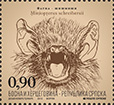 Motive:Common bentwing bat
Motive:Common bentwing bat
Catalogue no.:606
Perforation:13 3/4
Face value:0.90 BAM
Quantity:20 000
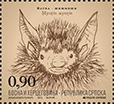 Motive:Long-eared bat
Motive:Long-eared bat
Catalogue no.:604
Perforation:13 3/4
Face value:0.90 BAM
Quantity:20 000
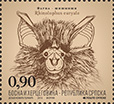 Motive:South horseshoe bat
Motive:South horseshoe bat
Catalogue no.:605
Perforation:13 3/4
Face value:0.90 BAM
Quantity:20 000
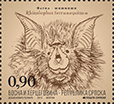 Motive:Greater horseshoe bat
Motive:Greater horseshoe bat
Catalogue no.:603
Perforation:13 3/4
Face value:0.90 BAM
Quantity:20 000
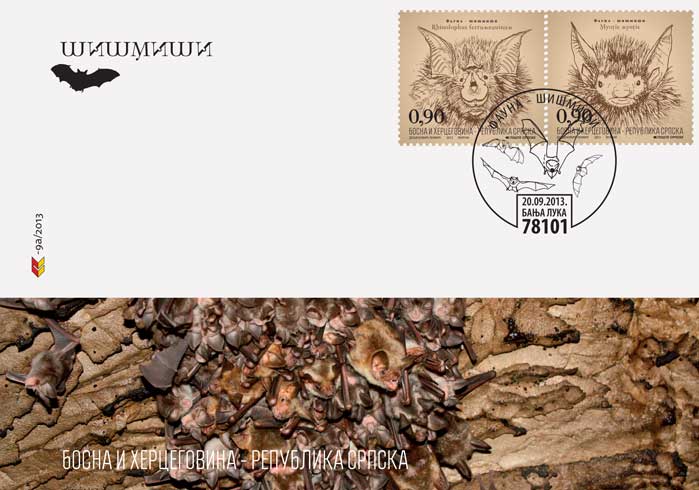
Bats, netopir or Spikes (Chiroptera) are an order of mammals characterized by the ability of the active flight and echolocation. Wings are of the skin that is tightly stretched between long fingers of their hands and wrists. Bats usually hunt at night and rest during the day, hanging upside down in caves, hollow trees, or buildings.
There are about 1,100 species of bats in the world, accounting for one-fifth of the total number of classified mammal species.
General feature of bats is the low rate of reproduction. In most cases, the female elevation of only one young annually.
Many bat species are endangered.
Greater horseshoe bat (Rinolophus ferrumequinum)
Settlements were mainly in southern Europe, France and southern England. In Central Europe the largest existing colonies located along the upper course of the Rhine.
Length of 7 inches without the tail and a wingspan up to 40 inches, making it the largest species of its family in Europe. It is easy to recognize the size and pronounced "saddle" on the nose in the shape of a horseshoe, from which they got their name. In summer, warm inhabit attics, church towers, ruins and caves. Since the beginning of October through the end of April retreat in abandoned mines, caves or other underground areas with a high percentage of moisture in the winter.
Long-eared bat (Myotis myotis)
It is widespread in the territory of almost all of Europe, but in the last 20 to 30 years, the density of its population has declined by 80%. Winter colonies of species live in caves, and the summer camps often found in attics and dilapidated homes and buildings, but also in caves and hollow trunks. This is quite a sensitive species leaving the residence for any form of harassment. Long-eared bat is one of the largest species of this genus.
Author: Nebojsa Djumic and МА Bozidar Dosenovic
Cooperation: Republic Institute for the protection of the cultural, historical and natural heritage of the Republic of Srpska
Publisher: Poste Srpske a.d. Banjaluka
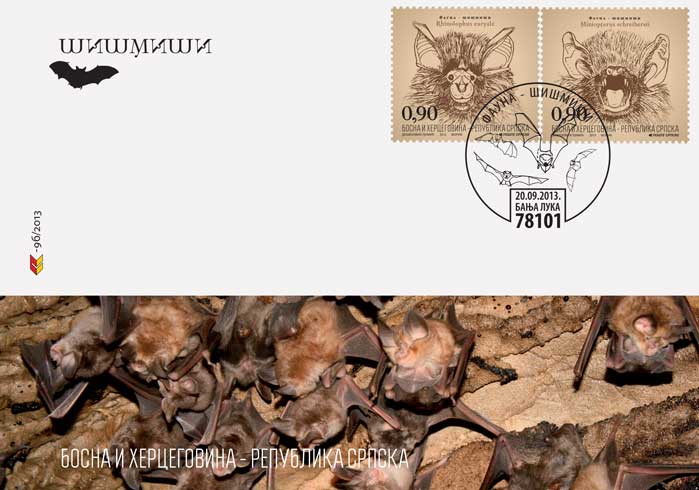
Bats, netopir or Spikes (Chiroptera) are an order of mammals characterized by the ability of the active flight and echolocation. Wings are of the skin that is tightly stretched between long fingers of their hands and wrists. Bats usually hunt at night and rest during the day, hanging upside down in caves, hollow trees, or buildings.
There are about 1,100 species of bats in the world, accounting for one-fifth of the total number of classified mammal species.
General feature of bats is the low rate of reproduction. In most cases, the female elevation of only one young annually.
Many bat species are endangered.
South horseshoe batRhinolophus euryale)
The species is widespread in the southern part of Europe and the northern range includes Slovakia, northern Italy and southern France. Recently, there was a strong decline in populations. This species occurs in forested areas, the preferred habitat of numerous karst caves. In summer sets in attics and towers. Winter in caves and tunnels with temperatures around 10 º C. Can often be found along with other types of Horseshoe. Fly out from their hiding place in the late twilight.
Common bentwing batMiniopterus schreibersii)
It is widespread in the Iberian Peninsula, central and southern France, western Alps, Italy, the Balkans and the Mediterranean islands. This is the only European species of the genus MiniopterusHe lives mostly in open and hilly areas and predominantly cave species. During the day visiting various crevices and abandoned mines. It is highly colonial species. Is categorized as "near threatened species," according to the Red List of the International Union for Conservation of Nature (IUCN).
Author: Nebojsa Djumic and МА Bozidar Dosenovic
Cooperation: Republic Institute for the protection of the cultural, historical and natural heritage of the Republic of Srpska
Publisher: Poste Srpske a.d. Banjaluka
 1371
1371  kontakt@postesrpske.com
kontakt@postesrpske.com


